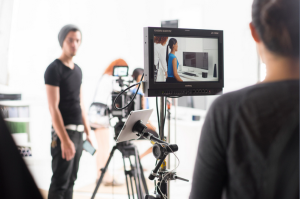6 Steps to Get Your Editor the Best Content
Are you a fledgling videographer and unsure if you’re hitting the right marks to earn your editor’s love?
As Four Winds Creative’s in-house editor who gets sent out to wield a camera every once in a while, I’ve been able to learn how to shoot while thinking like an editor—yet also often kicking myself with regret when in post. In the past two years I’ve edited professionally for FWC and the many years spent vlogging before that, I’ve come to grasp my preferred style and what I consider to be helpful in my workflow. So here are some reminders and tips to hopefully help ensure that nobody’s kicking anything.
(This is my opinion and may or may not apply to other editors’ preferences!)
1. Wait until a moment is over before cutting or adjusting.
As an editor, I hope for an audience to be immersed in the content of the video without abrupt reminders that there are folks puppeteering their digital view. Never interrupt a moment; let the subject finish their action, emotion, or speaking before stopping down or making a sudden change. It is tempting to adjust your camera positioning or settings to improve your shot thereafter—however I’d rather have the unideal, but complete shot, then try to make up for it in post. Color correction or a crop or rotation might just fix it.
2. Keep your subject in focus for 2 seconds minimum.
Sounds obvious, but you might be surprised at how easy it is to believe you’ve got a usable shot when you’ve only captured a glimpse. This also ties into being immersed in the video—it’s hard to be invested in something fleeting before you get a good look. I do love a good rack focus, but perhaps try thinking to yourself, “One-one-thousand, two-one-thousand…” before you move on from your main subject.
3. Cut when changing your shot. 
On the other hand, it’s also helpful to be concise enough to have different subjects of b-roll separated by clip. For example, you’re shooting some smiling people, and then you spot some good signage to capture—but the intention isn’t for them to be in the same shot. In edit, I may be looking for that piece of signage—and it saves a lot of time if I’m able to find that subject by clicking through thumbnails instead of having to scrub/watch through the clip. Also, it may possibly be motion sickness-inducing when a camera is left rolling through a set-up move.
White balance!
Remember that? I’m sure you do. Sometimes I don’t. And then I kick myself over some muddily-colored shots that aren’t easy to salvage.
4. Be aware of the tone of the video or event.
Nothing like putting together a video about how happy people are when there are no shots of people being happy. If a shot list (and/or interview questions if applicable) was provided, give it a read and sync up with the producer or director. Is the message about how cool the event is, or how engaged the attendees are? Are employees being showcased having fun at work or getting accomplishments done? Is the tone collaborative, personal, or a mixture of both?
5. Get signage and wide shots for context.
![]() Signage is usually required—but if for example you’re shooting a large event with sub-events or activities, your editor would appreciate having a shot of, say, a sign establishing that we’re at the “Alumni Gathering” or wide shot of many alumni appearing to have gathered. Sometimes I’ll get feedback that the viewer can’t tell what’s going on in the video (in the case of this example, perhaps I’ve only included shots of small groups of alumni interacting), which is when I’ll look to insert some sort of contextual shot. So it’s always awesome to have those standing by! And including the client’s branding is never a bad thing—they’re paying for a video to further their own brand and awareness after all, and not for a generic video that could have been cut from stock footage.
Signage is usually required—but if for example you’re shooting a large event with sub-events or activities, your editor would appreciate having a shot of, say, a sign establishing that we’re at the “Alumni Gathering” or wide shot of many alumni appearing to have gathered. Sometimes I’ll get feedback that the viewer can’t tell what’s going on in the video (in the case of this example, perhaps I’ve only included shots of small groups of alumni interacting), which is when I’ll look to insert some sort of contextual shot. So it’s always awesome to have those standing by! And including the client’s branding is never a bad thing—they’re paying for a video to further their own brand and awareness after all, and not for a generic video that could have been cut from stock footage.
6. Keep diversity in mind.
It isn’t uncommon now for clients to request better representation of genders, races, etc.—which is a great thing! It’s also usually a plus to capture diverse folks working or engaged in something together.
That’s all I’ve got for now! Thanks for reading, and happy videographing.
